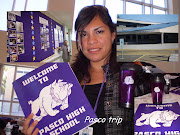Video Podcast
ESL/EFL podcast
“Around the world with “Little Finger”
1.- Description of intended students:
My students are 2nd grade High School students, in Chile. Their ages are between 14 and 15 years old. They are a class of 40 students, and all of them just speak Spanish. Most of them are not really motivated to learn English; however, they are very motivated to meet new people, listening to music, surfinf on the Internet, sharing with their friends, etc. They come from the middle socioeconomic class, and they almost none of them have access to Internet at their home but they have access to Internet in the school, and in cybercafes.
What they need to know is that English is a useful tool that they can use to do many of the activities they like to do; besides, they need to know that English is a very important language all around the world (lingua franca).
2.- Description of language objectives and content objectives
Content objectives for the series:
Through a series of different podcasts related to places to visit around the world, types of animals around the world, primary and secondary colors; and shapes inside the classroom; students will be able to identify, interpret, and campare/contrast some of the most used adjective qualifiers to describe different places around the world. They will also be able to label, and classify colors as primary and secondary. Besides, they will be able to indicate and classify different shapes inside the classroom.
Language objectives for the series:
Students will be able to write short dialogues using verbal tenses (future tense- will and going to) to express some functions of the language.
Students will be able to perform dialogues with a classmate, using some specific verbal tenses.
Students will be able to tell an imaginary experience they would like to have when travelling abroad, using the future tense (will, and going to)
Content objectives for the individual podcast:
By watching this video podcast, students will be able to recognize, identify, and use some of the most used adjective qualifiers to describe landmark places around the world.
Language objectives for the individual podcast:
By writing a composition, students will have to use appropriately some adjectives to describe places aroud the world.
In pairs, students will have to build dialogues in which they use comparatives and superlatives of adjectives. this dialogue have to reflect their position about the place they would like to visit, and why they would like to visit it.
By recording a video perfomed by them, students will be able to realize of the differences between “going to” and “will” to express future tense, and they will acquire more lexicon (adjectives used to describe places.)
Explanation of reasoning; connect with students' needs:
I decided to plan these objectives for my students because I think that it is very important for them to be motivated before to and while learning a topic, whaterver it is. The objectives are really challenging for students, and they were made thinking on their likes and dislikes so that they get interested in what they are doing, and they fit with the students' needs. For example, I uploaded this videopodcast to "youtube" so that students can look for it on the Net (what they like a lot); thus, students are motivated, and the content explain in the class is more meaningful for them.
What makes this podcast comprehensible is the use of a series of multimodalities in it. We can watch video, we can listen to a person speaking about the topic. Also, we can see pictures of the different places that the person is talking about. The music is also a support in this podcast because in each of the scenes there is music related to the places that are being presented.
All those characteristics make the podcast a very useful strategy for the teacher to use in pos to engage his/her students in what he/she is presenting them and asking them to do.
It is also important to mention the fact that the podcast is funny, and that it has my voice what makes it more attractive to my students, who I think will laugh, and will feel motivated to watch it several times to understand what it talks about.
4.- Description of the strategies that we have covered that have informed the choices that you have made with the podcast and how will use it with students.
One of the strategies I used was trying to implement “Multimodality” in my podcast. I know that we as teachers have to consider our students' learning styles when creating activities, so I decided to use this strategy in order to get my students' understanding on what they are watching, and also to get them actively involved in the topic.
I also got support my podcast in the strategy related to the use of the four skills used together. Although the podcast does not contain the four macroskills, I tried to include these skills in the activity I will propose to my students to do later.
http://www.youtube.com/watch?v=GlpAX2uVCGI












1 comment:
Hi Abbie,
I enjoyed the journey with "Little Finger." This was an entertaining way of communicating the lesson! Very creative.
Good work,
Lisa Avery
Post a Comment